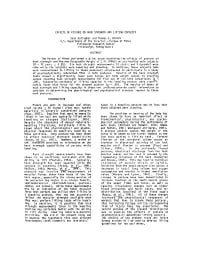Mining Publication: Effects of Posture on Back Strength and Lifting Capacity
Original creation date: September 1997
Authors: S Gallagher, TG Bobick
NIOSHTIC2 Number: 20023255
Ergonomics and Musculoskeletal Disorders: Research on Manual Materials Handling, 1983-1996, W Karwowski; MS Wogalter; PG Dempsey, eds., 1997 Sep; :37-41
The Bureau of Mines performed a pilot study examining the effects of posture on back strength and Maximum Acceptable Weight of Lift (MAWL) on six healthy male subjects (M = 32 years + 4 SD). Six back strength measurements (3 static and 3 dynamic) were made while the subjects were kneeling and standing. In addition, these subjects (who were unaccustomed to lifting in these postures) volunteered to participate in a study of psychophysically determined MAWL in both postures. Results of the back strength tests showed a significantly lower peak torque per body weight output in kneeling versus standing back strength measurements for five out of six test comparisons (p < .05). Subjective estimates of lifting capacity in the kneeling posture were significantly lower than those for the stooped posture (p < .05). The results of back strength and lifting capacity in these two postures provide useful information to consider in determining the physiological and psychophysical stresses imposed by these work postures.

NIOSHTIC2 Number: 20023255
Ergonomics and Musculoskeletal Disorders: Research on Manual Materials Handling, 1983-1996, W Karwowski; MS Wogalter; PG Dempsey, eds., 1997 Sep; :37-41
- Biomechanical Modeling of Asymmetric Lifting Tasks in Constrained Lifting Postures
- A Comparison of Fatigue Failure Responses of Old Versus Middle-Aged Lumbar Motion Segments in Simulated Flexed Lifting
- Effects of Lifting in Four Restricted Postures
- Effects of Posture on Dynamic Back Loading During a Cable Lifting Task
- The Effects of Restricted Workspace on Lumbar Spine Loading
- Electromyography of the Thigh Muscles during Lifting Tasks in Kneeling and Squatting Postures
- An Exploratory Study of Loading and Morphometric Factors Associated with Specific Failure Modes in Fatigue Testing of Lumbar Motion Segments
- Lifting in Stooped and Kneeling Postures: Effects on Lifting Capacity, Metabolic Cost, and Electromyography of Eight Trunk Muscles
- Torso Flexion Loads and Fatigue Failure Mode of Human Lumbosacral Motion Segments
- Trunk Extension Strength and Muscle Activity in Standing and Kneeling Postures